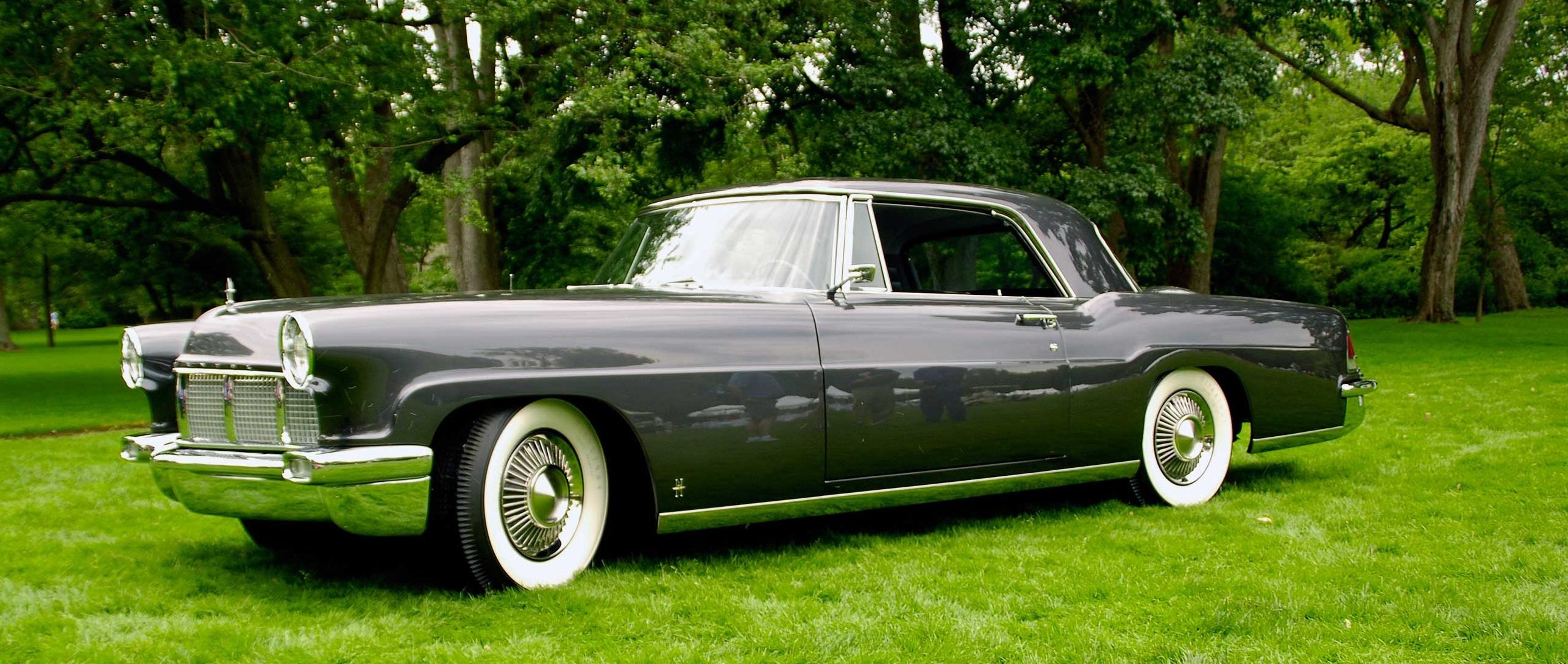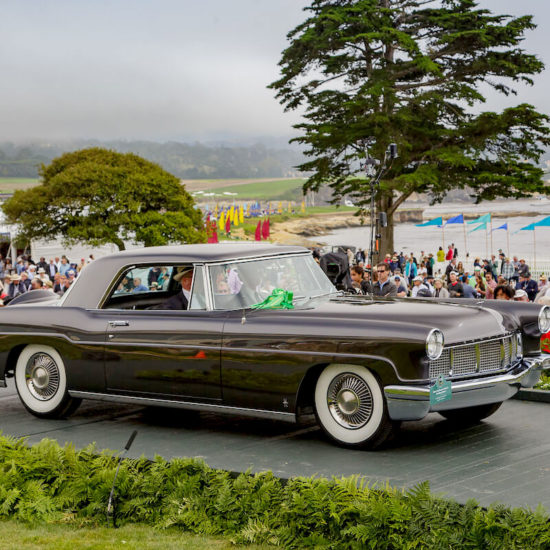Owner: Leon Flagg & Curt Lamon

- Dealer Special Ordered: Exterior Color, Interior Trim & Mechanical Accessories
- Body Style: Hardtop Coupe
- Model No. II-60A
- Engine No. 2367
- Firewall No.1337HC
- Cylinders: V8; CID 368; 285bhp @ 4600rpm
- Brakes: 4 drums
- AC: Yes.
- Length: 218in.
- Wheelbase 126in.
- Weight: 5100 lbs
Awards:
- First in Class, The 71st Pebble Beach Concours d’Elegance (Class E – Lincoln Zephyr and Continental Through 1962) – Pebble Beach, CA – August 21, 2022
- Best in Class, The 2013 Salisbury Concours d’Elegance (Class – Lincoln) – Des Moines, IA – September 2013
- Best in Class, The 2010 Glenmoor Gathering (Class – American Post-War) – Canton, OH – September 2010
- Most Elegant Award, 2009 Krasl Art Center Concours – St. Joseph, MI – August 2009
- Designer’s Choice (Best in Class) 2008 Eyes On Design (Class – PPG ‘Windshield Wrapture’) Edsel Ford Mansion, Grosse Point, MI – June 2008
- AACA Grand National First Place & Preservation Award – Hickory Corners, MI – June 2007
- Best in Class, The 2006 Grand Experience at Gilmore – Hickory Corners, MI – June 2006
- Emeritus Award – LCOC Eastern Nat’l Meet – Hickory Corners, MI – June 2006
- Best in Class, 2004 Concours d’Elegance at Cranbrook (Class O – American Closed after 1944) – Bloomfield Hills, MI – July 2004
- National First Prize, Senior – AACA National Meet – Metropolis, IL – May 2004
- Best in Class, 2nd Annual Hilton Head Island Concours d’Elegance (Class – Post-War Avant Garde Closed) – Hilton Head, SC- November 2003
- National First Prize, Junior – AACA National Meet – Metropolis, IL – July 2003
- Press Award & 1st Place – Cuneo Concours d’Elegance (Class – Post-War Luxury) – Lake Forest, IL – September 2002
- Best of Show & 1st Place, Senior Class – LCOC Mid-Western Nat’l Meet – Houston, TX – October 2001
- 1st Place, Senior Class “Lincolns for the Millennium” – LCOC, LZOC & LOC 80th Anniversary Combined Meet – St. Louis, MO – Sept. 2000
- 1st Place, Primary Class & Lincoln Trophy – LCOC Eastern Nat’l Meet – Atlanta, GA – May 2000
History of this Example
T he original invoice for this unique Continental Mark II, provided by the Henry Ford Archive, denotes that C56 J 3348 features Dealer Special Orders (DSOs) across the board. Meaning that the original purchaser swept aside the factory’s luxurious offerings of color and material in favor of singular personalized choices, paying a premium over the already considerable list price set for this exclusive new offering.
 Hand-made, C56 J 3348 is one of only 16 Mark II’s to leave the plant with the factory option of mouton (lamb’s wool) carpeting. It’s exterior color is specified as “Special Lucite Grey Metallic”, not standard “Deep” or “Medium Grey”, and it’s presented today in that stunning hue. The interior is leather in two tones of grey which faithfully reproduce the grain, texture and color used at Continental and, as per the DSO, these are arranged in a variation of the standard color placement. One will also notice that certain mechanical features of this very late ’56 example demonstrate that Continentals were built with running changes and not strict adherence to model year. C56 J 3348 is indeed one of a kind.
Hand-made, C56 J 3348 is one of only 16 Mark II’s to leave the plant with the factory option of mouton (lamb’s wool) carpeting. It’s exterior color is specified as “Special Lucite Grey Metallic”, not standard “Deep” or “Medium Grey”, and it’s presented today in that stunning hue. The interior is leather in two tones of grey which faithfully reproduce the grain, texture and color used at Continental and, as per the DSO, these are arranged in a variation of the standard color placement. One will also notice that certain mechanical features of this very late ’56 example demonstrate that Continentals were built with running changes and not strict adherence to model year. C56 J 3348 is indeed one of a kind.
Originally delivered in Santa Ana, CA with time spent in Michigan and Texas, C56 J 3348 was completely and authentically restored over 5 years to debut to top honors in 2000.
History of the Marque & Model
T he Continental Mark II is not a Lincoln. The short-lived Continental Division of Ford Motor Company was inaugurated to produce a car finer than Lincoln, more prestigious than Cadillac. It was hoped the Mark II would revive the market—dormant since the end of the Classic Era—for an exclusive, hand-built personal vehicle. An era during which Edsel Ford was an acknowledged master of automotive artistry. As Edsel Ford had sponsored the original 1940-48 Lincoln Continental, his son William Clay Ford, is responsible for the development of the Mark II.
Once the decision to build a new Continental was made by Ford—specifically Edsel’s eldest son Henry II—Henry’s brother and the youngest of Edsel’s three sons, William Clay Ford, age 23, was designated to lead the project and the new Special Products Division which would develop the car. The young Mr. Ford surrounded himself with seasoned professionals—many of them contemporaries of his tasteful father—who shared similar aesthetics. The agreed goal was to create something that would embody and move forward the design ethic of Edsel Ford. “Modern Formal” came to denote the concept.
The “Modern Formal” design, developed by Chief Stylist John Reinhart (formerly of Packard), implies the cars lineage to the original Continental, but updates the themes for the 1950s. Chrome and fins were eschewed in favor of restrained lines and classic proportions. The legendary Classic Era stylist Gordon Buehrig (Duesenberg, Cord) served as Body Engineer.
Ford management, fearing the team may fail, did commission four other styling designs by well-respected outside stylists. The story of how Ford execs were sent in to a room one by one to view and vote for anonymous renderings is the stuff of legend. The Hollywood, but true, ending is that the design by William Clay Ford’s Special Products Team prevailed.
Engineering by Harley Copp is unique to the Mark II; not shared with contemporary Lincolns. Featuring a cow-belly chassis, the design allows for a low-slung vehicle while providing chair height seating inside. To accommodate such clearance, the exhaust system is routed through the side rails of the cow-belly. Engines were selected from the Lincoln Premiere line, but following bench-testing, the best were torn down and rebuilt to yet higher tolerances before installation in a Continental.
There are many testaments to the dedication and attention to detail which Special Products showered on Mark II such as the debate over faux vents in the front fenders – nixed because they could not be functional; the cow-belly frame; the chrome specs five times tougher than Cadillac; the gun-sight manufacturer elected to produce the iconic hood mascot and much more.
Suffice to say this was clearly a very personal endeavor for William Clay Ford and his team, as well as the hierarchy of Ford Motor Company. Few compromises in quality, concept or execution were tolerated. The Special Products Division was renamed the Continental Division and the Mark II debuted at the Paris Auto Show in October 1955.
At the legendary price of $10,000.00 (a Cadillac could be had for $5000.00 to 6,000.00), Mark II was expected to lose money, but gain prestige for Ford Motor Company. Not so closely calculated was the decision to take closely-held Ford public about the same time Mark II was to debut. Intended red ink became unacceptable on the corporate ledgers and the Quixotic endeavor was canceled. 3000 examples were built from late 1955 to mid-1957, roughly half are believed extant.
